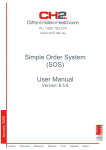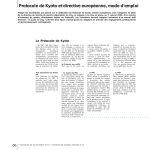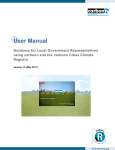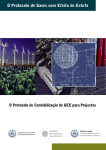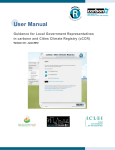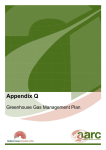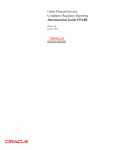Download User manual - Orchard Carbon Tool
Transcript
DISCLAIMER: The information contained in this publication is intended for general use, to assist public knowledge and discussion and to help improve the sustainable management of land, water and vegetation. It provides general knowledge about carbon accounting in relation to the Australian Orchard Industry, but is by no means an extensive reference on the topic. It includes general statements based on public knowledge and/or scientific research. Readers are advised and need to be aware that this information may be incomplete or unsuitable for use in specific situations. Before taking any action or making decisions based on the information in this publication, readers should seek expert professional, scientific and technical advice. Although the South Australian Research and Development Institute (SARDI), and its partners have taken all reasonable care in preparing this advice, neither SARDI, nor its employees, consultants, or partners accept any liability resulting from the interpretation or use of the information set out in this document. Orchard Carbon Calculator Manual 2 Contents Introduction ............................................................................................................................................ 4 What is the Orchard Carbon Calculator? ............................................................................................ 4 How does it work? .............................................................................................................................. 4 Why do you need a carbon calculator? .............................................................................................. 4 Climate change........................................................................................................................................ 5 What is climate change? ..................................................................................................................... 5 Carbon, carbon dioxide and carbon dioxide equivalents ................................................................... 5 Is climate change an issue for Australia? ............................................................................................ 5 Before you start ...................................................................................................................................... 6 Data you will need to complete the tool ............................................................................................ 6 Orchard Carbon Calculator: Setup .......................................................................................................... 7 First-time users ................................................................................................................................... 7 Orchard Carbon Calculator: Orchards..................................................................................................... 8 Creating a new orchard....................................................................................................................... 8 Updating orchard details .................................................................................................................... 9 Orchard Carbon Calculator: Step-by-step ............................................................................................. 10 Step 1: Energy ................................................................................................................................... 11 Step 2: Waste .................................................................................................................................... 13 Step 3: Fertiliser ................................................................................................................................ 14 Step 4: Refrigerants .......................................................................................................................... 15 Step 5: Land use change ................................................................................................................... 16 Step 6: Sequestration........................................................................................................................ 17 Step 7: Fruit quantity ........................................................................................................................ 18 Orchard Footprint ................................................................................................................................. 19 Additional resources ............................................................................................................................. 21 Orchard Carbon Calculator Manual 3 Introduction What is the Orchard Carbon Calculator? The Orchard Carbon Calculator is an online tool that will help Australian orchardists calculate their on-orchard greenhouse gas emissions. It will identify the greenhouse gas emission associated with: • • • • • • Fuel. Electricity. Contractor vehicles. Fertiliser. Refrigerants. Land use change. It also provides an estimate of carbon sequestration by fruit trees. The tool is designed to be used once each year. After growers have collected relevant information on orchard material and energy inputs, it should only take approximately 1 hour to complete. The Calculator will help growers identify which areas of their operation contribute most significantly to their carbon footprint. Through collecting data on orchard inputs, growers may also identify opportunities for cost reduction. How does it work? The Orchard Carbon Calculator uses a library of emission factors, which convert farming inputs (e.g. Litres of diesel consumed) into greenhouse gas emissions. If the grower is interested in the specific emission factors employed in calculations they should refer to the Orchard Carbon Calculator Protocol, which is available for download from the website. Why do you need a carbon calculator? There is currently no statutory requirement for most growers to perform carbon accounting for their orchard. However, a clear understanding of carbon emissions will become increasingly important as consumers become more interested in the carbon footprint of the products they buy, which in turn promotes retailer interest and pressure up the supply chain. By being proactive with respect to their carbon footprint, growers will be informed and better prepared for whatever may happen in the future. It may also help prevent much more onerous carbon footprinting processes with high compliance costs being imposed on them by others. Orchard Carbon Calculator Manual 4 Climate change What is climate change? Climate change is caused by increased concentration of greenhouse gases in the atmosphere. These gases trap heat, leading to global warming. The scientific consensus is that the increased concentration of these gases in the atmosphere is principally related to human activity (i.e. it is anthropogenic). The Intergovernmental Panel on Climate Change (IPCC), formed in 1988 is the leading international body for the assessment of climate change. In their fourth and most recent assessment report in 2007, they concluded that “warming of the climate system is unequivocal” and that “most of the observed increases in global average temperatures since the mid-20th century is very likely due to the observed increase in anthropogenic greenhouse gas concentrations.” Carbon, carbon dioxide and carbon dioxide equivalents The principal greenhouse gas of interest in climate change is carbon dioxide (CO2 – i.e. a molecule consisting of one carbon atom bonded to two oxygen atoms). However, there are a number of other greenhouse gases that also contribute to climate change, notably methane (CH4) and nitrous oxide (N2O). Each of these gases has a different influence on climate change per kg of gas. In work relating, to climate change, instead of reporting results for all the different greenhouse gases individually, totals are often presented as the quantity of carbon dioxide that would have an equivalent influence on climate change (i.e. carbon dioxide equivalents). Emissions in the Orchard Carbon Calculator are all expressed in terms of carbon dioxide equivalents. It should also be noted that it has become popular, particular in mainstream media, to describe carbon dioxide or carbon dioxide equivalent emissions simply as carbon emissions. This abbreviation is a confusing misnomer that has now become part of the language. Is climate change an issue for Australia? In absolute terms Australia only contributes small amounts of greenhouse gases to the global atmosphere, relative to emitters like China, India, the European Union and the United States of America. However, on a per capita basis, Australia is one of the largest emitters in the developed world. While it is true that the absolute quantity of emissions is the critical factor in terms of effect on global climate change, some argue that Australia is vulnerable to the effects of climate change and it is therefore in the national interest to champion the reduction of global greenhouse gas emissions. There is also some risk that Australia’s high per capita emissions could be used as an excuse by other to impose trade barriers. Orchard Carbon Calculator Manual 5 Before you start Data you will need to complete the tool In order to estimate your on-orchard carbon footprint, you will need to collect information relating to the material and energy inputs on your orchard. You will be able to complete your carbon footprint more quickly if you have already collected this information. You will need: • • • • • • • • Electricity bills or meter records for the reporting year. Fuel bills/receipts/records for the reporting year (i.e. natural gas, petrol, diesel, LPG, wood). Records of fertiliser usage for the reporting year. You will also need information on the percentage of nitrogen in each fertiliser, where available. Relevant service documents for non-ammonia based on-site cold rooms or industrial freezers for the reporting year. If you do not have any relevant service documents you will still need to know the charge size of the refrigeration system and the refrigerant used. Records of the number of hours contractors used tractors, utes, motorbikes and cherry pickers on the orchard during the reporting year. The quantity of native forest and/or native grassland cleared for the orchard during the reporting year and the 19 years preceding it. The number of hectares of fruit trees on the orchard in the reporting year and the number of hectares of fruit trees that were on the orchard on 31st December 1989. The quantity of fruit produced on the orchard in the reporting year. Note: The website will guide you through the process and save all the data you enter at the end of each page (i.e. after you click “Save & Next”). So even if you do not have all the required information when you start, you will be able to enter what you do have, and then come back and add additional information as you collect it. Orchard Carbon Calculator Manual 6 Orchard Carbon Calculator: Setup Go to www.orchardcarbontool.com.au (i.e. Type this address into the address bar on your web browser) First-time users If this is the first time you have used the site click on “Register” from the “Carbon Calculator” menu on the right of screen. This will take you to the registration page. Fill in the registration details. You may choose any user name you wish, provided another user has not already chosen it. If you are an SPC Ardmona grower please ensure that you select that “Yes” you are an SPC Ardmona grower from the drop-down box which is initially set to “No”, then enter your unique SPC Ardmona grower number (between 0001 and 9999) and answer the data sharing question. Once you have completed all the fields, click the “Submit” button. After a successful registration a link will appear on the screen. To begin adding information about your orchard(s), click on this link. Note: Your registered user name will be emailed to the supplied email address to confirm your registration, but your password will not. Please take note of your user name and password and keep them somewhere safe. You will need these for future logins. Orchard Carbon Calculator Manual 7 Orchard Carbon Calculator: Orchards Creating a new orchard First-time users will have to create an orchard to which data can then be attributed. To do this click on the link “click here to create a new orchard”. Give the orchard a name and select the State in which the orchard is located (using the drop-down box). State selection is important as this will ensure that appropriate state specific emission factors are used, where appropriate. Once you have entered this information, click “Submit”. If you have more than one orchard, repeat the instructions above until you have entered all of your orchards into the database. If different fruits are grown in the same location (or for different purposes), you could consider treating these as separate orchards; however, you will only be able to do this if you have specific non-overlapping information on material and energy inputs for each one. If in doubt, you should take the conservative approach and include everything at that location as one orchard. Orchard Carbon Calculator Manual 8 Updating orchard details Users who have already created an orchard(s) can edit information about that orchard. To modify the name/state of an orchard, click on the orchard from the list, then modify the name/state and click “Submit”. To delete an orchard and associated data from the database, click on the orchard from the list and then click on “Remove orchard and all data” under the “Delete data” heading. To delete data for a particular year only, similarly click on the orchard from the list, but then click on the specific year under the “Delete data” heading. Note: You can access this page at any time when using the Orchard Carbon Calculator. Simply click on “Update orchards on my profile” listed under “My orchards” in the “Carbon Calculator” menu on the right of screen. Orchard Carbon Calculator Manual 9 Orchard Carbon Calculator: Step-by-step Once your orchards have been created you can now move on the data input stage. You should try and answer the questions as accurately as you can. In some instances you may need to make an estimation. If an answer is 0 you can simply leave the input space blank and it will automatically be recorded as zero. To navigate, while using the calculator you should only use the links and buttons on the screen. Do not use the browser’s back and forward buttons as this may result in data not being saved correctly. For your reference, this Manual and the Protocol can be viewed at any time by clicking on the relevant link in the “Documentation” menu on the right of screen. This Manual presents information on the general use of the Orchard Carbon Calculator, while the Protocol contains specific details on calculation methodology. Orchard Carbon Calculator Manual 10 Step 1: Energy Click on “Step 1: Energy” (listed under “Data input” in the “Carbon Calculator” menu on the right of screen. Ensure that you have selected the correct orchard and year from the drop-down boxes at the top of the page. Answer all the questions on the page then click the “Save & Next” button. For the quantity of LPG consumed under each “Mobile fuels” and “Stationary fuels” quantities of LPG purchased on a volume basis (L) and a mass basis (kg) should be entered separately. For electricity this is the quantity of electricity you consumed from the grid, including that from renewable energy/GreenPower from the grid. If you generate renewable electricity on the orchard yourself, for example with solar panels, you will still likely require some electricity from the grid to supplement your own power generation (e.g. when the sun is not shining or you have a high demand for electricity). This quantity of makeup electricity consumed from the grid is what should be entered in the electricity quantity input box. Please note that electricity generated by your solar panels and put back into the grid (e.g. when you have a low demand for electricity) is not to be included. For “Contractor vehicles” you will notice that the input quantities are in terms of the hours contractors used each type of equipment on the orchard in the reporting year. The Orchard Carbon Calculator employs hourly fuel use factors for contractor vehicle use, as the grower will often not have access to data on the contractor’s fuel use. For each contractor vehicle type you will need to input the total number of hours that contractors used one piece of that equipment on the orchard. For example, if contractors used 5 cherry pickers simultaneously on the same orchard for 400 hours, the value that would need to be entered for contractor cherry pickers would be 2000 hours. Orchard Carbon Calculator Manual 11 Orchard Carbon Calculator Manual 12 Step 2: Waste Enter the relevant data in the input boxes provided in a similar manner to that for Step 1. The inputs are in terms of cubic metres (1 m × 1 m × 1 m) of piled wood. Click the “Save and Next” button. Orchard Carbon Calculator Manual 13 Step 3: Fertiliser Enter the data for synthetic and organic fertiliser use in the input boxes provided. For each fertiliser used, inputs need to be made for the name, the quantity used, and the nitrogen content of that fertiliser. All registered fertilisers should display a chemical analysis on their packet giving the nitrogen content. However, for some unregistered local organic fertilisers like animal manure and compost, the nitrogen content may not be available. Some indicative nitrogen content values for use in the Orchard Carbon Calculator can be obtained by clicking on the “What is the nitrogen content of my fertiliser?” link near the bottom of the page. Click the “Save & Next” button. Orchard Carbon Calculator Manual 14 Step 4: Refrigerants Enter the data for orchard refrigeration systems in the input boxes provided. These refrigeration systems will typically be associated with on-site cold rooms or freezers. The Orchard Carbon Calculator allows up to 2 different refrigeration systems to be considered. Only refrigeration systems employing hydrofluorocarbon (HFC) or hydrochlorofluorocarbon (HCFC) refrigerants need to be considered. Refrigeration systems using ammonia (R-717) as the refrigerant do not need to be included because ammonia has a negligible global warming potential. If you have service documents that indicate how much refrigerant was added to the system in the reporting year, the quantity of refrigerant leaked in the reporting year can be estimated from this value. If you have these records you should answer “Yes” to having service records and input the quantity and type of refrigerant added based on these records. Often you will not have these records. In this instance, select “No” and input the charge size of the refrigeration system and the refrigerant and the Orchard Carbon Calculator will use default loss factors from the literature for the calculation. Click the “Save & Next” button. Orchard Carbon Calculator Manual 15 Step 5: Land use change Enter the number of hectares of native forest and/or native grassland cleared in the reporting year and the 19 years preceding it. Please note that is related to the conversion of native forest or native grassland to agricultural land. Areas of land should only be included if it was the first time that it was converted from native forest or native grassland to agricultural land. When you use the Orchard Carbon Calculator for the next reporting year the previously entered data on land use change will be auto-filled. Click the “Save & Next” button. Orchard Carbon Calculator Manual 16 Step 6: Sequestration Enter the number of hectares of fruit trees on the orchard in the reporting year and the number of hectares of fruit trees that were on that orchard on 31st December 1989 in the relevant input boxes. The difference in area will be used to estimate the carbon sequestered by the orchard, potentially eligible under the Kyoto Protocol (provided a number of other criteria are met). If you do not know the area of fruit trees on 31st December 1989, please make an estimate. This value will be auto-filled when the Orchard Carbon Calculator is used for the next reporting year. Click the “Save & Next” button. Orchard Carbon Calculator Manual 17 Step 7: Fruit quantity Enter the quantity of saleable fruit produced in the reporting year. This will be used to calculate the emissions per quantity of fruit produced (t CO2e / t fruit). Click the “Save & Submit” button. This will take you to the “Orchard footprint” page. Orchard Carbon Calculator Manual 18 Orchard Footprint The orchard footprint results are displayed in a table, a pie chart and also in a yearly comparison column chart. The table presents the total on-orchard carbon footprint, with emissions separated as Scope 1 (direct), Scope 2 (indirect from electricity generation) and Scope 3 (other indirect) and also the combined Scope 1, 2 and 3 emissions. The annualised carbon sequestration possibly eligible under the Kyoto Protocol (provided a number of other criteria are met) is also presented. The combined Scope 1, 2 and 3 emissions are also reported per tonne of fruit produced, both including and excluding emissions associated with land use change. While native to agricultural land use change can be a significant contributor to emissions, under internationally accepted carbon accounting methods the emissions associated with the change are generally distributed over a somewhat arbitrary time period (20 years). Consequently, the 2010 emissions of an orchard which had cleared native land in 1991 could be significantly higher than an orchard that cleared similar native land in 1990. For this reason the emissions are presented both including and excluding land use change. For general comparisons between orchards, the emissions per tonne of fruit excluding land use change is likely the better metric. The pie chart illustrates how each emission component contributes to the orchard’s overall carbon footprint and allows the user to quickly understand which components of their operation are most significant. The yearly comparison chart illustrates how emissions have changed over the different years the calculator has been used, and allows the user to track their performance over time. Orchard Carbon Calculator Manual 19 Orchard Carbon Calculator Manual 20 Additional resources For additional information on climate change and carbon accounting the following websites are recommended: (1) The Department of Climate Change and Energy Efficiency. www.climatechange.gov.au. • • This is the relevant Australian Government department. There are many documents available for download from this website, including the National Greenhouse Accounts and details of methods employed in their estimation, and information on the Carbon Farming Initiative. (2) The Intergovernmental Panel on Climate Change (IPCC). www.ipcc.ch • • The Intergovernmental Panel on Climate Change (IPCC) is the leading international body for the assessment of climate change. It was established by the United Nations Environment Programme (UNEP) and the World Meteorological Organization (WMO) in 1988 to provide the world with a clear scientific view on the current state of knowledge in climate change and its potential environmental and socio-economic impacts. Numerous relevant technical publications are available for download from this website. (3) The United Nations Framework Convention on Climate Change (UNFCCC). www.unfcc.int • • • This convention sets an overall framework for intergovernmental efforts to tackle the challenges posed by climate change and enjoys near universal membership. The Kyoto Protocol, which sets binding greenhouse gas emission reduction targets for many industrialised countries, is linked to the UNFCCC. This website provides useful information on international climate change policy. (4) The Greenhouse Gas Protocol Initiative. www.ghgprotocol.org • • The Greenhouse Gas Protocol Initiative was jointly convened in 1998 by the World Business Council on Sustainable Development (WBCSD) and the World Research Institute (WRI). A number of carbon accounting publications and tools are available for download from this website. Orchard Carbon Calculator Manual 21





















